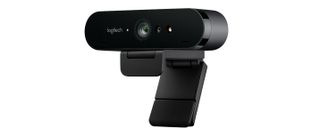Webcams fall into an ill-defined area between digital cameras and video camcorders. Today, the best webcams have the ability to take both great quality pictures and to capture high-definition video. Due to webcams falling into this grey area, there is no set standard for how to describe each webcam's capabilities. One webcam may be listed as 2.0 megapixels and another as 1080p. This webcam has a 'normal' aspect ratio, but this one has a '16:9' aspect ratio. At this point, you may be wondering what this all means - below, we cut through confusing tech jargon so you'll know exactly what each camera can do.
HD or High Definition
720p and 1080p are high-definition resolutions, with 1080p being the best available (and likely built into the best laptops) until you get to 4K Ultra High Definition. While this is now a common resolution for all the best TVs, is something you're probably not going to be managing with a simple webcam. The 'p' is short for 'progressive scanning'. For example, 720p really means 1280x720 pixels, where 1280 represents the number of horizontal pixels and 720 represents the number of vertical pixels. A 720p television will progressively scan 921,600 pixels (1280x720) on the screen every 1/60 of a second - older CRT screens used interlacing (switching between odd and even lines every frame) but progressive scanning provides a better picture. The more pixels that can be progressively scanned onscreen, the better the video quality.
Megapixels
Megapixels are an image quality description usually associated with digital cameras. Taking our last example of 1280x720, or 921,600 pixels, this would come to .9 megapixels (MP), or one megapixel if you round up (mega means one million). As you can see, the formula to arrive at both descriptions of resolution are exactly the same, just described differently.
There are two main reasons why webcams are either described in megapixels or in terms of HD resolution. The first is because some consumers can easily identify with a product that has its resolution described in megapixels as opposed to HD resolution and vice versa. The other reason for the two different descriptions for video resolution is a separate measurement: the aspect ratio.

Aspect Ratio
The aspect ratio is a common reason why a webcam is either described as HD or in terms of the number of megapixels. HD webcams, or webcams that are described in terms of 720p or 1080p resolution, have an aspect ratio of 16:9, which is a widescreen view.
When it comes to a webcam that has a 'normal' (3:4, like the sensor in a DSLR camera) aspect ratio, you are more likely to see the resolution listed in terms of megapixels. When you see a webcam for which the video resolution is listed in megapixels, expect the picture to be almost as tall as it is wide.
VGA
VGA is a descriptor that usually refers to 640x480 resolution, which is the same resolution of a standard definition television. Webcams that are VGA are not considered high-definition webcams. These are entry-level webcams that shoot video at a resolution of 640x480 pixels, or .3 megapixels or below. This type of webcam is usually powered by older technology (CCD), whereas most high-definition webcams now have more modern CMOS sensors.

Photo Interpolation
You may notice that a webcam may not have great video quality but is still able to take high-quality photos. This doesn't necessarily have anything to do with the webcam itself. The software that comes with the webcam is what digitally enhances the quality of the pictures. When you see that a webcam can take up to 20MP interpolated photos, it actually means that the webcam itself doesn't have that capability, but the software can upgrade the quality of the photos to 20MP.
Frame Rate
Frame rate is an extremely important specification to recognize. Frame rate is usually described in terms of frames per second (FPS). The higher the frame rate, the more fluid the streaming video will be. You will find webcams that have HD-quality video 1080p resolution but have better quality video with less skipping or choppiness at 720p at 30FPS. This is because at 1080p, the webcam and CPU have to process much more information than at 720p, thus slowing the frame rate down to 10FPS or lower, which in turn creates less fluid video.

